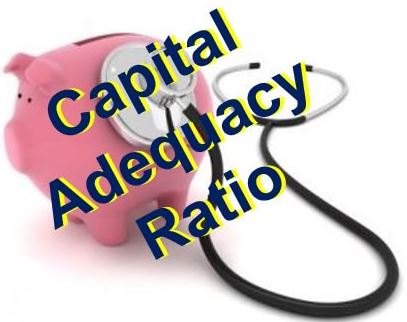Capital adequacy ratio used to find out the proportion of any bank capital along with the total risks bank is having with weight assets like lending a loan to any individual. However, the risk is around 0% for amount give to the government, but on the other side, the risk is high in percentage for the lending loan to individuals.
Capital Adequacy Ratio:
The ratio represented in the form of a percentage. A higher percentage means the bank is running well, collecting their investment, and the lower percentage is a sign of risk to the bank, and it may even come up with some adverse effects.
The second case, The very higher capital adequacy ratio means a bank is not using its capital for lending to the customers. The worldwide regulators have introduced the Basel 3, which require banks to put more capital on the investment in terms of the lending loan to the customers while maintaining a minimal risk.
Capital Adequacy Ratio Formula:
The numerator in the capital adequacy ratio is the total capital sum of tier 1 capital of the bank and tier 2 capital of the bank.
- Common equity is also known as Tier 1 capital that includes share capital, retained earnings, and other incomes, Intangible assets, and other smaller adjustments.
- Subordinated debt, revaluation reserves, and related stock surpluses include in Tier 2 capital of the bank.
The risk-weighted assets of the bank that includes credit risks, operational risk-weighted assets, and market risk-weighted assets are in the denominator. This represented in the form of a ratio, and usually, the higher percentage of capital adequacy ratio implies safety for the bank.
The mathematical formula of Capital adequacy ratio is:
Capital Adequacy Ratio Formula = (Tier 1 Capital + Tier 2 Capital) / Risk-Weighted Assets
Calculation with Example:
Calculating the capital adequacy ratio is easy, and you can do it by merely using an excel sheet online or Ms excel program on your desktop.
Let us show you by using an example:
Suppose we have tier 1 capital and tier 2 capital details of the bank along with the risk-weighted assets and details are as follows:
Bank A ($ Million):
Tier 1 Capital = 148
Tier 2 Capital = 57
Credit Risk Weighted assets = 1200
Market Risk Weighted assets = 350
Operational Risk Weighted assets = 170
Capital Adequacy Ratio =?
Solution:
#1 First, you need to calculate the total risk-weighted assets.
Total Risk-weighted Assets = Credit Risk Weighted assets+Market Risk-Weighted assets+Operational Risk Weighted assets =?
Total Risk-weighted Assets = 1200+350+170 =1720
Total Risk-weighted Assets = 1720
#2 For calculation of CAR (Capital Adequacy Ratio) You need to add Tier 1 Capital and Tier 2 Capital and divide with the total risk-weighted assets.
CAR = Tier 1 Capital + Tier 2 Capital / Total Risk-Weighted Assets
CAR= (148+57) /1720
CAR = 11.9%
So, the ratio for the above example of the bank is 11.9%, which is usually a higher percentage to maintain the risks.
Conclusion:
CAR (Capital Adequacy Ratio) often used for analyzing the risk covered in assets of the bank. Example the risk of getting the amount of loan back. The higher the percentage of CAR, the better rate of the dignity of the bank. A low ratio indicates that the bank has no capital for the risk-associated assets.








